Subscribe now to get notified about IU Jharkhand journal updates!
Cattle Rearing Business: Challenges and Prospects for Post-Covid-19-lockdown Economic Recovery and Sustainable Development of South-East Nigeria
Abstract :
This study looked at the business of cattle rearing in the 21st century Nigeria with particular reference to the southeast region. The broad objective of the study is to critically assess cattle rearing business in Nigeria vis-à-vis its challenges, prospects and implications for post-covid-19-lockdown recovery and sustainable development of the southeast region. The study was subjected to empirical test using regression analysis with the aid of SPSS version 21 to find out the contribution of the cattle rearing business to post-covid-19-lockdown economic recovery and sustainable development of the southeast region using data sourced from a sample of 400 respondents drawn from the five states that constitute the Southeast region. The regression analyses show that beta (standardized coefficients) is 0.959, r = .959, while r2 = 0.929, which is about 92.9% contribution. This implies that cattle rearing business will contribute significantly to economic recovery and sustainable development of the southeast region in the post covid-19-lockdown era & beyond. In order to achieve this feat, the study recommended ranching of cattle; the reintroduction of local breed (known as Efi-Igbo) where they have gone into extinction in the region; and involvement of the youths of the region in the cattle business as a veritable means of employment creation; post-covid-19-lockdown economic recovery; and sustainable development of the region.
Keywords :
Cattle Business,Covid-19, Economic Recovery, Sustainable Development1. Introduction
In Southeastern Nigeria, with over 18,713,600 population, spread across five states; ninety-five local government areas; and numerous communities east of the Niger (south east Nigeria), evidently, there appear to be an abundant market for beef (cattle business) in the region. South east Nigeria accounts for a greater percentage of the Nigerian population with the five states having (as mentioned earlier) over 18,713,600 people (according to 2006 population enumeration of the National Population Commission), which include 4,112,230 for Abia state; 4,177,828 for Anambra state; 2,176,947forEbonyi state; 3,267,837 for Enugu state; and 4,978,758 for Imo state, respectively. (National Population Commission, 2006)
This teeming population depends largely on beef for their meat consumptions on daily basis;this indeedis a huge market for cattle rearing business in Nigeria.However, demand for beef offers both challenges and prospects to Nigeria in general and rewards and risks for herders/farmers in particular especially in this covid-19 lockdown era where the economy was shut down for nearly five consecutive months.
Generally, for Nigeria as a country, with over 200milion people, and an emerging middle class, Nigeria is witnessing a boom in demand for meat that offers potential but also risks for the semi-nomadic herders who provide most of its beef.According to Umar (2007), as at 2007, the number of cows that exchanges hand in the meat market in Nigeria was put at 15.3 million per annum.This is grossly inadequate to meet the beef-needs of over 200 million Nigerians, let alone, exporting beef-products to other nations. In fact, available records have shown that Nigeria is not even among the top 20 nations in the global cattle business.
According to Rob Cook (2020), world cattle inventory ranking of countries, published on the 19 July, 2020 on Beef2live webpage, the global cattle inventory as at 19 July 2020 stood at 987.5million. Top Five Nation Cattle Inventory include: India (303,200,000 cattle), Brazil (244,144,000 cattle), USA (94,413,000), China (91,380,000), and EU with 86,594,000 million cattle; Top Five Milk Exporters include: New Zealand ($4.4b USD), Germany ($2.6b USD), Netherlands ($1.9b USD), France ($1.5b USD), and the fifth nation is USA with $1.4billion USD; and Top Five Beef Exporting Nations include: Australia ($5.6B USD), USA ($5.2b USD), Brazil ($4.3b USD), India ($3.7b USD) and the fifth nation is the Netherlands with an export value of $2.7 billion USD.(Rob Cook, 2020)
Now, with all the noise in Nigeria about Cattle and with all the tensions it creates unnecessarily, sadly, Nigeria is not even in the top 20 nations in the global cattle business. In fact, Nigeria still imports about 30% of her beef-needs from the neighbouring Niger Republic, Cameroon, Chad and Mali. And according to CBN report), Nigeria still spends about 1.5 billion USD on milk importation annually and the CBN attributed the low milk proactivity that gave room for heavy milk importation to cattle mobile pastoralism. (Bello, 2019; Nwosu 2019)
All of these figures are disheartening, alarming and indeed a bad omen for this nation, which supposedly prides herself on cattle rearing. But then again, opportunely, that is also how huge the prospect for the market is, and with these figures we can imagine what Nigeria would have been losing in the African Continental Free Trade Area if these areas are not leveraged upon.
In the Nigeria cattlebusiness today, most of the demand is met by pastoralists from theethnic Fulani group, who follow time-honoured techniques ofraising cattle, driving them south to pastures and taking them tomarket.During the dry season, the herders come down from the aridSahel to the fertile plains of central and southern Nigeria, seekingwater and pasture for their livestock.(Mercy Corps NGO, cited in Vanguard Nigeria Newsonline, June 26, 2019)
The tension this old practice is generating in this 21st century Nigeria is that the millennia-old activity has been thrust into the spotlight in the recent years because of worsening confrontations withsedentary farmers over access to land and water. Clashes have claimed 7,000 lives over the past five years and cost the Nigerian economy $13 billion (11.57 billion euros) annually, this is according to a report by an NGO, Mercy Corps as published in the vanguard news online of June 26, 2019.The feud has roots dating back more than a century. Droughts,population growth, the expansion of sedentary farming intocommunal areas but also poor governance have all played arole. Also, many markets and outdoorslaughterhouses (abattoirs) lack basic sanitary conditions, such as runningwater, animal shelters and cold storage rooms.
On the other hand, also,opportunities and prospects and even more challenges for cattle rearing abound. As Nigerians clamour for meat, can this ancient practice — withits long supply chains, climate risks and social tensions —compete against sedentary farming, which has high productivityand lower risks? There are varied opinions for answer to that poser.Many Nigerians and veterinary experts have been clamouring for global best practices in rearing of animals in Nigeria, which according to them is simply by method of Ranching.While this appears tobe the majority view of many Nigerians (that is, adopting global best practices of rearing animals such as ranching) some other public commentators such as Jimmy Smith (director of the Institute for International Research on Livestock Farming (ILRI), based in Nairobi) holds a contrary view.
Jimmy Smith, director of the Institute for International Researchon Livestock Farming (ILRI), based in Nairobi, cited in Vanguardngr (June 26, 2019) argues that thesystem can not only survive but also flourish — in the rightconditions. He opines that the model can prosper if the right support is put in place. He suggested for example, that it is possible to grow more forage and grain insub-humid zones to create and develop feed markets forlivestock based in northern areas, where it is dry and that one animal which can give two litres (3.6 pints) of milk today could give 10 litres in the future.
In the recent times, government is mulling several plans to boost rearing of cattleand ease tensions over access to land. They include initiatives for the creation of “cattle colonies” — dedicated areas where pastoralists can graze their animals and have access to veterinary and other care and more recently,the establishment of RUGAsettlement (RUGAis aHausa term that means cow settlement) all over the 36 states of the countrywhich did not go down well with many Nigerians and was massively resisted, and has since been suspended by the federal government after its meeting of 2nd July, 2019, chaired by the vice president, Prof Yemi Osibanjo, as reported inthe national dailies. (Itodo, July 24, 2019, Dailypost News-online; Punch Nigeria News online July 3, 2019)
Nonetheless, Nigeria’s hunger for meat is likely to be replicated across Africa, if expectations of population and income rise hold true. The UN’s Food and Agriculture Organization (FAO) quoted in Vanguard Nigeria News (June 26, 2019) estimates the continent will experience a doubling in consumption of beef, pork and chicken between 2015 and 2050.
Nigeria has considerable livestock — nearly 20 million cattle, 40 million sheep and 60 million goats — but about 30 percent of slaughtered animals are purchased from abroad, mainly from neighbouring Cameroon, Chad, Mali and Niger. Often the herds are driven for hundreds of kilometres (miles) to be sold at border markets likeIllela, a trading post between Niger and Nigeria. The animals are then trucked to the cities, where they are sold again, slaughtered and butchered.(Vanguard Nigeria News, June 26, 2019)
With the foregoing, looking at these prospects and challenges, the study critically examined how to leverage the massive prospects that abound in rearing of cattle,while still eliminating the bottlenecks of cattle business for sustainable economic development of the southeast region.
1.1 OBJECTIVES OF THE STUDY
The broad objective of this study is to critically assesscattle rearing business in Nigeria, its challenges and prospects for post-covid-19-lockdown economic recovery and sustainable development of southeast Nigeria. Specifically, the paper sought to:
1.1.1 determinethe extent to which the quantum of market-share available for cattle rearing in the southeast can enhance post-covid-19-lockdown economic recovery and sustainable development of the region.
1.1.2 assessthe viability of reintroductionof the local Igbo breed of cattle (Efi-Igbo) through ranching as a way of eliminating incessant longstanding feud between herders/farmers.
1.1.3 ascertain the extent to which southeast youths are ready to embrace cattle rearing businessfor post-lockdown economic recovery and sustainable development of southeast region.
1.2 RESEARCH QUESTIONS
1.2.1 To what extent does the quantum of market-share available for cattle rearing in the southeast enhance post-covid-19-lockdown economic recovery and sustainable development of the region?
1.2.2 To what extent is reintroduction of the local Igbo breed of cattle (Efi-Igbo) through ranching as a way of eliminating incessant longstanding feud between herders/farmersviable?
1.2.3 To what extent are southeast youths ready to embrace cattle rearing business for post-lockdown economic recovery and sustainable development of the region?
1.3 HYPOTHESES
H01: The quantum of market-share available for cattle rearing in the southeast does not significantly enhance post-Covid-19-lockdown economic recovery/ sustainable development of the region.
H02: Re-introduction of the local Igbo breed of cattle (Efi-Igbo) through ranching as a way of eliminating incessant longstanding feud between herders/farmers is not significantly viable.
H03: The extent of Youths readiness in southeast to embrace cattle rearing business as a means for post-lockdown economic recovery/sustainable development of the region is significantly not encouraging.
2.0 METHODOLOGY
2.1 RESEARCH DESIGN
The study adopted survey design.
2.2 AREA OF STUDY
The geographical area of study is southeast Nigeria. Southeast region consists of five (5) states, which include: Abia, Anambra, Ebonyi, Enugu, and Imo state, with a total of ninety-five (95) local government areas and a total population of 18,713,600 people. This population includes: 4,112,230 for Abia state; 4,177,828 for Anambra state; 2,176,947 for Ebonyi state; 3,267,837 for Enugu; and 4,978,758 for Imo state. (National Population Commission, 2006)
2.3 POPULATION OF THE STUDY
The population is infinite. The population of the study consists of all the people involved in one way or the other in cattle business such as butchers at the abattoirs; cattle husbandmen (ie., people in charge of animal husbandry) and so on. Most of these people are uneducated and do not have accurate record (data) about the number of people involved in the business. However, the number of abattoirsin the southeast is estimated at about 760.Generally, two main characteristics of population are that it can either be finite or infinite. A population is finite when the population figure is known and the population is infinite when the figure is unknown(Nkamnebe, Ogwu,&Ezejelue, 2008). Thus,the population of the study is therefore, infinite because the figure of the population of beef consumers is unknown.

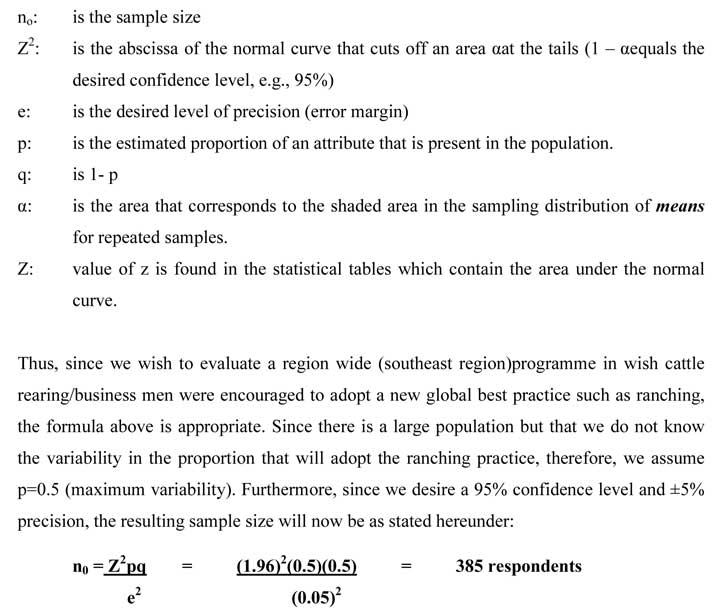
However, to account for possible missingand uncompleted copies of the questionnaire, 5% of 385 were also added, so that we now have 0.05 x 385 = 19 additional copies, added to the original 385 which will now sum it up to404copies.
3.0 DATA PRESENTATION AND ANALYSIS
The data garnered from the field survey are hereunder presented and analysed.
3.1 DATA PRESENTATION
3.1.1 DESCRIPTIVEDATA
The following descriptive data as garnered from the field survey is tabulated and presented hereunder:
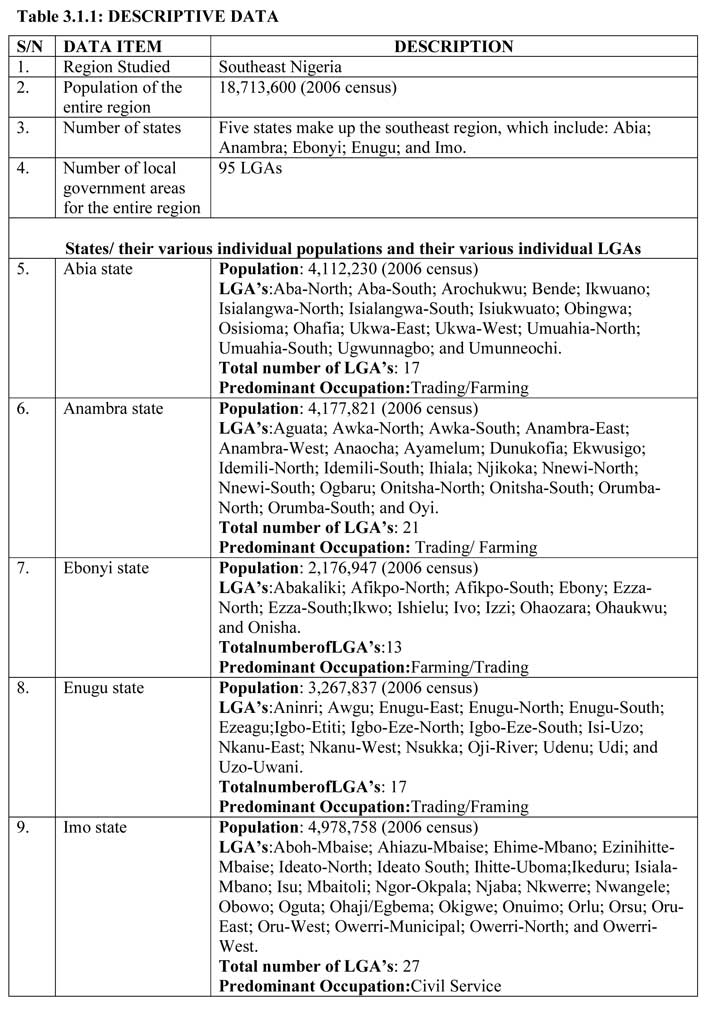
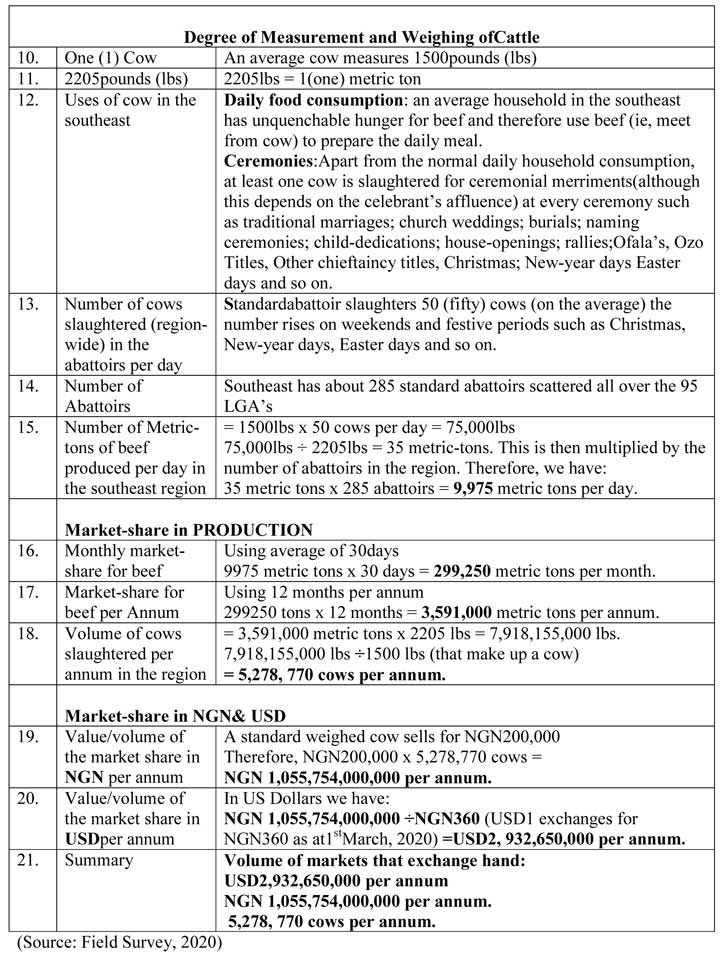
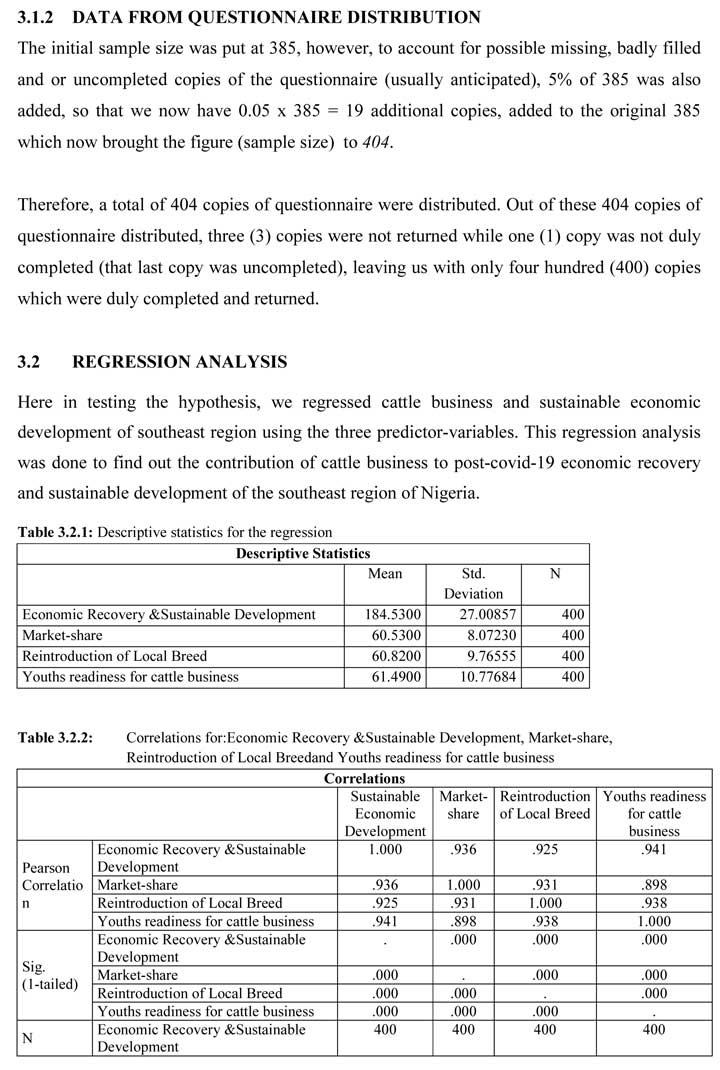
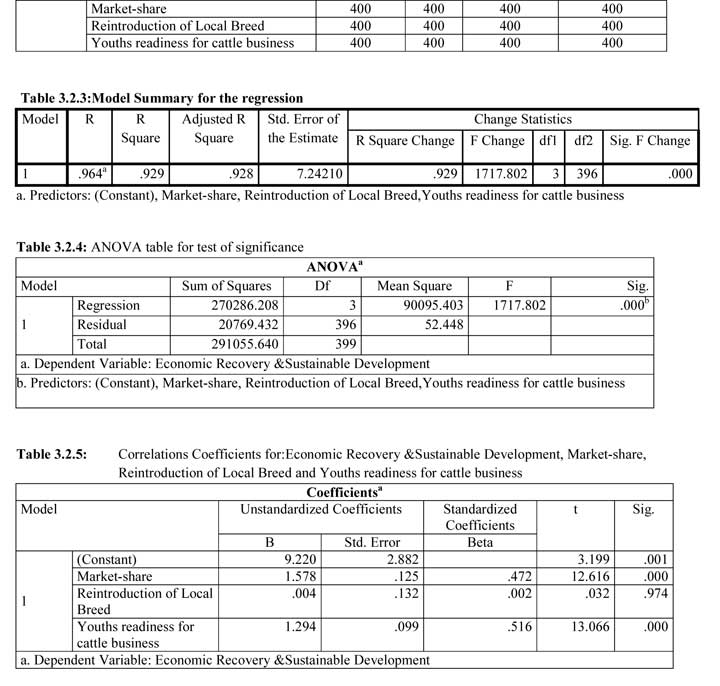
3.3 INTERPRETATION OF THE RESULTS
The model summary table shows whether the model is a good fit:
R is the correlation coefficient measuring the strength of the linear relationship (whether it is perfect, very strong, strong, fair, weak, very weak or not correlated at all) and the direction of the linearity (whether it is positively correlated or negatively correlated). In this case the result shows that the two variables are positively correlated and very strong too, r = .964. This simply means that Post-covid-19 Economic Recovery & Sustainable Developmentof the southeast region and the three variablesof cattle business measured (i.e.,Market-share, Reintroduction of Local Breed(Efi-Igbo) and Youths readiness for cattle business) are all positively correlated.
R-squared is the coefficient of determination, more usually expressed as a percentage. Here, it tells us that 92.9% (adjusted r-squared is 92.8%) of Economic Recovery & Sustainable Development of the southeast region (for meat market) is explained by the variability inthe cattle business variables measuredwhich are:Market-share, Reintroduction of Local Breed(Efi-Igbo) and Youths readiness to adopt cattle business.
The standard error of the estimate can be thought of as a typical residual; the difference between what is predicted by the model and what is observed.
The ANOVA table above shows a significant value of .000. This indicates that the regression is significant, which shows a useful linear model. Thecoefficients table tells us that the equation that models the line has a slope of .929 and an intercept of 14.665. We need to also know if this is actually significant. This is indicated by the significant column on the right. Sig value of 0.000 indicates that the coefficients is significant (p< .0005). The t-value column has done a t-test to test if the probability coefficient is zero given the sample data, and the sig column is the p value for the test which is .000 (p< . 0005). Therefore, our coefficients are ok, so going by the regression formula: y = bx + a, our regression line would now be: Post-covid-19 Economic Recovery & Sustainable Development of the southeast region= 0.929 x cattle business + 14.665.
The regression analyses show that beta (standardized coefficients) is .959. Hence, we have (r = .959, r2 = 0.929, % = 0.929 x 100 = 92.9%)
The above interpretation simply shows that those three variables of cattle rearing business measured which are: Market-share, Reintroduction of Local Breed(Efi-Igbo) and Youths readiness to adopt cattle businessexplain and accountfor 92.9% of Economic Recovery & Sustainable Development of the southeast region in the area of meat market while the remaining 7.1% can be attributed to other meat products such as: chicken, pork, goat, etc.
4.0 IMPLICATIONS &DISCUSSION OF FINDINGS
4.1 First Objective
The first specific object of the study is to determine the extent to which the quantum of market-share available for cattle rearing in the southeast can enhance Covid-19 Post-lockdownEconomic Recovery & Sustainable Developmentof the region.In doing this, the study found that almost all household consumes beef every other day whichcater for their daily meat need.The study found that about 5,278,770 cowsare slaughtered per annumin the southeast region and deals of about NGN1, 055,754,000,000(USD2,932,650,000)exchanges hands.With these volume and degree of business, southeast, indeed, has a huge market-share in the Nigeria Meat Market. This further validated the contribution of 92.8% total contribution.
4.2 Second Objective
The second specific object of the study is to assess the viability of reintroduction of the local Igbo breed of cattle (Efi-Igbo) through ranching as a way of eliminating incessant longstanding feud between herders/farmers.The study found that it will not only be viable, but also that,Ndi-Igbo pride the use of Efi-Igbo as the rich cultural heritage of Ndi-Igbo. In fact, some respondents expressed sadness that after the war, the entire southern Nigeria appeared to have given up on agriculture as a business allowing the North to take the initiative. They argued thatwhile they we were growing up, they learnt of the Obudu Cattle Ranch and other ranches from where local varieties of livestock such as cows, goats and sheep were reared. These varieties which were indigenous to the evergreen vegetation zones were much more nutritious and highly prized than their lean and long-legged Sahelian counterparts.
For instance, Ohanaeze Youth Council, OYC, leader, Comrade Igboayaka O Igboayakastatedthat“when you hear an Igbo chief hailed “Ogbuefi” the cow so referred to, is not Sahelian, the long-legged cows which today trample our farmlands and gorge on our crops. It refers to the shorter but heavier forest oxen which you do not find on the roadside butcher’s table. It is a delicacy for specialized ceremonies reserved for titled chiefs and those around them. Before the war, people kept those local varieties of livestock as subsistent business behind their backyards. It is time we went back to this practice”.
4.3 Third Objective
In examining objective number three which was to find out the extent to which southeast youths are ready to start cattle rearing business for Post-lockdownEconomic Recovery & Sustainable Development of the region,it was found that the youths of the southeast region are evidently and significantly ready for cattle rearing businessif given the necessary and required support and assistance.
This finding collaborated with the recent statement released the 4th of July, 2019(see maazi.online of 5th July 2019) byOhaneze Ndigbo (youth wing) that they are ready to commence cattle rearing business in the region. Ohanaeze Youth Council (OYC),in a bid to find a lasting solution to herdsmen/farmers’ clashes in the Southeast, haspassionately appealed to governors in the region to provide funds for farmers in the zone to invest in cattle business and other livestock farming.In a press statement issued by the national president of OYC, Igboayaka O Igboayaka, and made available to newsmen in Owerri, the group contended that if such assistance was rendered by the governors, it would not only encourage indigenous cattle rearing in the zone but also reduce unemployment.He also noted that the idea would end the constant herdsmen and farmers’ incidents in the zone. (Seemaazi.online of 5th July 2019, @ www.maazi.online)
According to the Ohanaeze Youth Council’sstatement, “in view of the raging war in these past years arising from settling of cattle herders in the South East and South-South regions, the Ohanaeze Youth Council, OYC, ably led by Comrade Igboayaka O Igboayaka, has seen reasons to urge governors of the Igbo extraction, to mobilise funds and empower indigenous farmers in the region to embark on a large-scale rearing of cattle and other livestock, using the ranching method for adequate production of milk and meat to meet the agricultural needs of our people.
5.0 CONCLUSION AND RECOMMENDATION
5.1 CONCLUSION
Evidently, theteeming population of Ndi-Igbodepends largely on beef for their daily meat consumption every other day and obviously this hunger for beef has proven unquenchable.Of course, indeed, southeast region is a huge market for cattle rearing business in Nigeria. However, this hunger for beef offers both challenges and prospects to Nigeria in general and rewards and risks for herders/farmers in particular especially in this post-covid-19 lockdown era. To this end, the study concluded that for there to be a Post-covid-19 Economic Recovery & Sustainable Development and peace in the region (in terms of cattle/meat market), ranching is advocated and the indigenousyouths of the region should be encouraged to embrace cattle rearing business especially the reintroduction of Efi-Igbo.
5.2 RECOMMENDATIONS
5.2.1 Ranching of all forms of animal (livestock)as a global best-practice is recommended. State houses of assembly in the southeast region should enact laws that will check mobile-pastoralism by way of legislating against open-grazing and firmly ensuring the enforcement of same in the region. This will in turn quench the longstanding feud between farmers and herders and increase food production and sustainability.
5.2.2 Reintroduction of the local Igbo breed of cattle (Efi-Igbo) where it has gone into extinction through ranching is recommended. In addition toEfi-Igbo, mix-breeding, cross-breeding, and rearing of different varieties of cattle species that account for attainment of business objective-function is advocated.This will particularly help the youths of the region and by extension, the entire region in general in the post-lockdown economic recovery and sustainable development.
5.2.3 Since it has been proven that the youths of southeast region are ready to embrace cattle farming as a veritable means of employment creation and sustainable development of the southeast region, it is recommended that the state governments in the southeast region should aid the indigenous youths/farmers to invest in cattle rearing and drive innovation in the agricultural sector as this high demand for beef in the states guarantees good returns on investment. This aid could be in form of; grants, soft-loan, agricultural microcredit loans, cooperative-society type of funding, provision of ranches and so on.
All of these recommendations will help cushion and mitigate the effect of the lockdown on the region in the post-lockdown era and beyond when implemented cautiously.
References
- Cochran, W.G. (1963). Sampling Techniques, 2nd Ed., New York: John Wiley and Sons, Inc. Cook, R. (2020). World Cattle Inventory: Ranking of Countries (USDA) as at July 19, 2020. Published by beef2live. Available online at; www.beef2live.com. Itodo, Y.(July 24, 2019). Buhari reportedly suspends RUGA settlement scheme. Daily Post Nigeria News online. Retrieved on the 3rd of July, 2020 from Daily Post Nigeria News online website: www.dailypost.ng.
- Nwosu, A. (July 24, 2019). CBN explains why it is banning other dairy products. Daily Post Nigeria News online. Retrieved on the 24th of July, 2020 from Daily Post Nigeria News online website: www.dailypost.ng.
- Bello, P. (July 24, 2019). MAN, LCCI kick against CBN’s planned forex restriction for imported milk. Daily Post Nigeria News online. Retrieved on the 24th of July, 2020 from Daily Post Nigeria News online website: www.dailypost.ng.
- Jimmy Smith, director of the Institute for International Research on Livestock Farming (ILRI), based in Nairobi, cited in Vanguardngr (June 26, 2019). Hunger for beef offers rewards and risks for Nigeria’s pastoralists. Vanguard Nigeria News online. Retrieved on the 16th of June, 2020 from vanguardngr website: www.vanguardngr.com.
- Mercy Corps NGO, cited in Vanguard Nigeria News (June 26, 2019).Hunger for beef offers rewards and risks for Nigeria’s pastoralists. Vanguard Nigeria News online. Retrieved on the 16th of June, 2020 from vanguardngr website: www.vanguardngr.com.
- National Population Commission (2006).Federal Republic of Nigeria 2006 population and housing census volume iv. Population distribution by age & sex (state & local government area), Abuja, Nigeria.
- Nkamnebe, A.D., Ogwu, F.O. &Ezejelue, A.C. (2008). Basic Principles in Managing Research Project. 93 Azikiwe Road, Aba, Abia, Nigeria: Afritowers ltd Publishers. Punch Nigeria News online (July 3, 2019). Breaking News: FG suspends Ruga. Punch Nigeria News online. Retrieved on the 3rd of July, 2019 from Punch Nigeria News online website: www.punchng.com.
- Umar, A.S.S. (2007). Financial analysis of small scale beef fattening enterprise in Bama local government area of Borno state Nigeria. MSc Thesis, Ahmadu Bello University Zaria, Nigeria.
- Agbakwuru, J. (July 3, 2019). Breaking: Buhari suspends RUGA Programme. Vanguard Nigeria News online. Retrieved on the 3rd of July, 2019 from vanguardngr website: www.vanguardngr.com.
